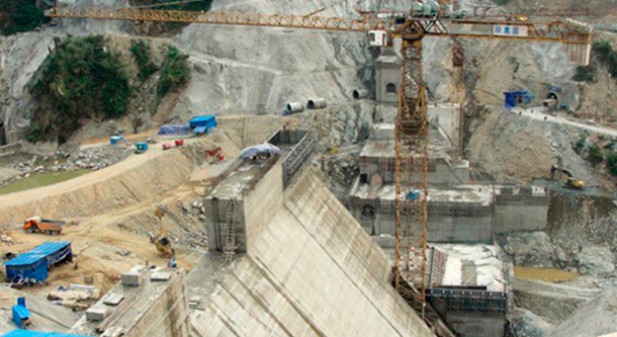As the Burmese government prepares to host an energy forum in Rangoon with proposals for coal fuel imports, a study of the country’s severe electricity supply deficiencies recommends a combination of natural gas and river hydro dams.
The study, by David Dapice, a Southeast Asian economic development specialist linked with Harvard Kennedy School in the US, also recommends avoiding the trend among neighboring countries to resort to coal power plants to feed rapidly rising electricity demand.
The release of the study comes as Rangoon was identified this week as one of several emerging Southeast Asian business cities facing “severe risk” of flooding and other calamities due to climate change. Coal burning is one of the worst causes of greenhouse gas emissions blamed for triggering global warming and climate change.
Dapice’s proposal, which coincides with Aung San Suu Kyi’s plea for environmentally friendly energy development, suggests that Burma’s development in the southern half of the country is fueled with natural gas and in the northern half by hydroelectric systems on rivers, notably in Kachin State.
Dapice suggests that Burma’s government renegotiates hydropower deals between the former military regime and Chinese state businesses to better benefit Burmese.
“The Myitsone and six other dams in Kachin State would have provided more than 10,000 MW of capacity. However, 90 percent of the power [under old contracts] would have gone to China. It is likely that Myitsone will be canceled since it is so sensitive and unpopular,” he said in his report for the Ash Center at the Harvard Kennedy School.
“If China wishes to salvage its past investment in dams and develop a mature and less extractive relationship with Myanmar, it will have to renegotiate the past contracts which were one-sided. The Kachin will have to be involved or else they will create instability.”
Dapice, also a professor at Tufts University in the US, says hydroelectric dams should form a pillar of Burma’s new energy plan but that it would be folly to rely primarily on them because of loss of generation in the dry season. He recommends also building power plants fueled by natural gas, which is reliable, domestically accessible and much cleaner than coal.
India, China and Southeast Asian countries will account for 40 percent of global electricity demand by 2030 and hydro-dam power systems and natural gas will dominate although coal will still be a very significant fuel source, a new industry assessment by the United States’ business development consultancy Frost & Sullivan forecast last week.
“Rapid urbanization and the creation of a middle class will drive electricity consumption in these emerging economies, as a wealthier population takes up electric appliances that are considered standard in the developed world,” said Frost & Sullivan.
However, the Burmese government appears to be gearing up to permit coal-fueled power stations to try to overcome the severe electricity shortages, as is happening in Bangladesh, Malaysia, Thailand and Indonesia.
An electricity industry conference planned for January in Rangoon aimed at attracting investors will discuss issues such as importing coal for new power station development, said the organizers, the Center for Management Technology of Singapore.
The conference on Jan. 28-31 will be attended by Power Minister Khin Maung Soe, who will put forward investment offers to a range of business executives expected to attend.
However, coal fuel is also a contentious issue. A special economic zone focused on a new industrial port at Dawei on the southeast coast has been held up since the government vetoed plans for a large coal-fueled electricity plant to power the development.
“Burma needs to build up its electricity-generating capacity fourfold as a minimum for a developing economy over the next decade,” regional energy industries analyst Jeff Mead in Hong Kong told The Irrawaddy. “That would mean at least 12,000 MW [megawatts] compared with what is probably today about 3,000 MW existing capacity.
“It’s going to mean 15 power stations of 600 MW capacities, for example, like the one being built now in Yangon. Bangladesh has twice as much electricity capacity as Burma right now but still faces severe blackouts daily which are seriously damaging the country’s textiles industry.
“In the short term coal could be the quickest solution to supply problems in Burma, as the Bangladeshis seem to have decided.”
But the polluting consequences of burning coal lie at the heart of climate-changing global warming, and in a new report by risk assessors Maplecroft of the UK, Rangoon is named among seven cities where “multinational companies operating in the Asian growth economies will be exposed to spiraling environmental risks.”
“As global corporations expand into the emerging growth markets, their operations and supply chains will become exposed to a complex set of climate risks that have the potential to disrupt business continuity,” said Maplecroft’s Helen Hodge. “It is essential for companies to identify where suppliers, assets and personnel are most at risk and plan for the long term.”
The seven Asian cities it says are at “severe risk” from flooding and other disruptive weather patterns are Rangoon, Dhaka, Bangkok, Manila, Jakarta, Ho Chi Minh City and Kolkata.
The seven are ranked as most vulnerable out of a Climate Change Vulnerability Index of 50 worldwide chosen for their “current and future importance to global business.”
Rangoon is ranked fourth most at risk.
“The vulnerability of cities in the growth economies stems not only from their exposure to climate related hazards, but also the sensitivity of their populations and the poor capacity of governments to support local adaptation measures to combat the potential effects of climate change,” Maplecroft said.
During her visit to India last week Aung San Suu Kyi visited the Energy and Resources Institute near New Delhi.
“[Burma] is rich in energy resources, but also needs investment,” she said in a speech there. “We look for responsible investment that is not only sensitive to the environment, but also secures the future of our country. We need to learn more about handling our energy resources. [Burma] also needs an effective energy policy.”

















